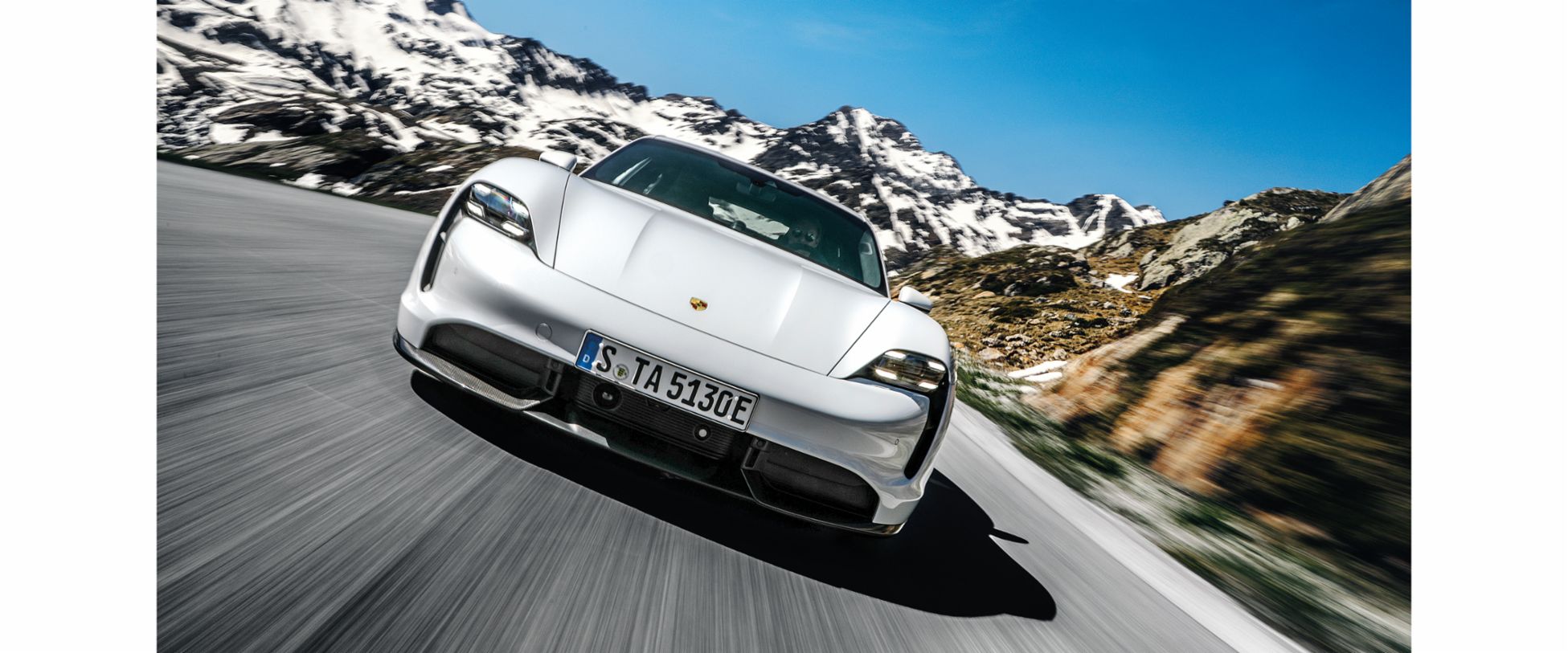Emotional Exterior Design
The Taycan is recognizable as a Porsche at first glance. It consistently transfers the brand’s design language into the world of electric cars—and will shape that world.
Consumption data
Porsche Taycan Turbo S
Electrical consumption combined: 26.9 kWh/100 km;
CO2 emissions combined: 0 g/km
Porsche Taycan Turbo
Electrical consumption combined: 26.0 kWh/100 km;
CO2 emissions combined: 0 g/km
(as of 10/2019)
“Design is the moment when imagination becomes something visible. When the intangible becomes tangible.” Michael Mauer, Vice President Style Porsche
Sporty proportions
The “flyline”—the sloping, flat roofline—is typical of Porsche and was the biggest challenge in designing the Taycan. The reason was that purely electrically powered vehicles are generally higher than conventional ones, due to the batteries in the car floor. For the Taycan, Porsche has found another solution—the foot garage, as it’s called, a recess in the battery in the rear footwell. This ensures the most comfortable rear seating possible, the low vehicle height of a sports car, and an extremely low center of gravity, which in turn guarantees more driving dynamics.

Striking front, sensational acceleration values
Falling bonnet, strongly arched fenders, two striking beads, air intakes instead of radiator grilles—the front of the Taycan immediately reveals where it comes from. Its acceleration values are sensational: in the top Turbo S version, the Taycan sprints from 0 to 100 kmh with up to 560 kW of overboost power and launch control in just 2.8 seconds. It reaches the 200 kmh mark in 9.8 seconds. Top track speed: 260 kmh (Porsche Taycan Turbo S: electrical consumption combined: 26.9 kWh/100 km; CO2 emissions combined: 0 g/km (as of 10/2019)). With a drag coefficient of 0.22, the electric sports car also offers the best drag coefficient of all currently available Porsche models—a decisive contribution to low energy consumption and a long range. The Porsche Active Aerodynamic (PAA) system offers a variable rear spoiler in addition to the adjustable air intakes at the front. An air suspension system also reduces the frontal area at higher speeds by lowering the Taycan in two stages.
A floating look
The three-dimensional design of the main headlights, coupled with the latest LED matrix generation, is the result of a great deal of development work. The primary objectives: even higher luminous yield, integration of all lighting elements in a single housing, and a new implementation of the Porsche graphics for daytime running light with its four dots. In the Taycan, the headlights aren’t flush with the body, but appear to float within side air intakes. Air flows around the headlights, is directed to the wheels, and exits behind the wheel arches. This calms the flow in the wheel arches. The result: advantages in aerodynamics, less resistance—and greater range.
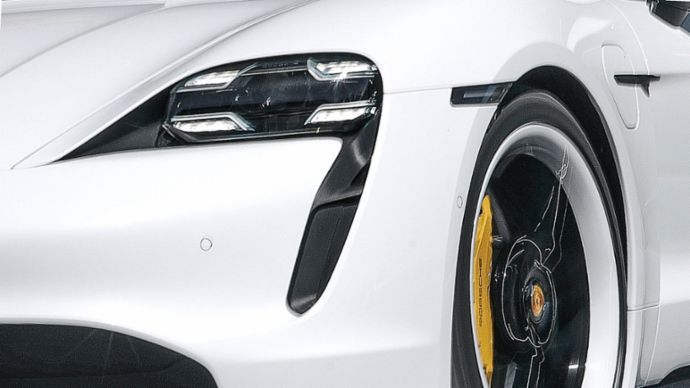


“I dare say that we have redefined the architecture of purely electric vehicles.”
Michael Mauer, Vice President Style Porsche
LED light strip
At first, the rear LED light strip with the Porsche logotype was reserved for the all-wheel-drive 911 models, but now every Porsche wears it—with the exception of the 718 models. The Taycan is the first time the manufacturer’s name has been visualized in three-dimensional glass letters. They’re embedded in an equally three-dimensional conductor graphic that can be configured optionally in black metallization and with lettering in the color Glacier Ice—a design that symbolizes the energy flow of the electric sports car.
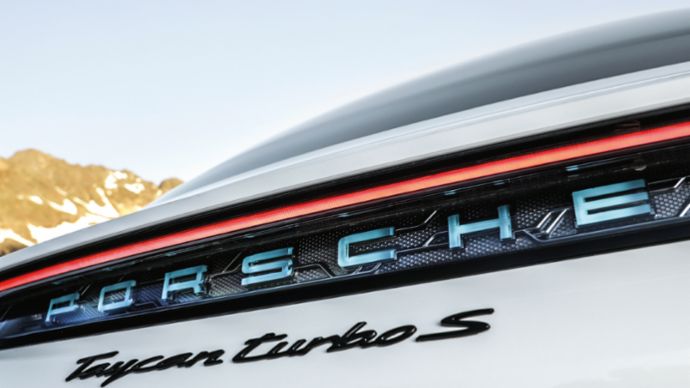
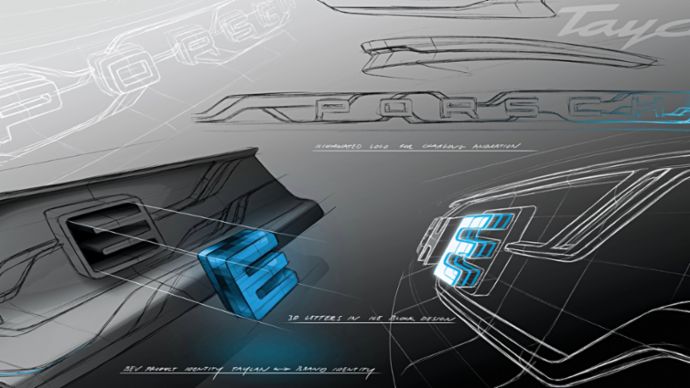
Integrated cooling air flaps
Compared to conventional vehicles with combustion engines, the Taycan’s cooling air intakes are significantly smaller. They complete the front at the bottom and, together with the flat front hood, emphasize its sporty character. The cooling air inlets also have a technical function: they not only supply the cooling circuit with air, but also direct the air to the brakes for cooling.
Sporty and dynamic wheels
Wheels optimized for aerodynamics and weight, in sizes ranging from twenty to twenty-one inches, have a positive technical effect with their low, unsprung masses and the right combination of cooling air dissipation from the brakes and streamlined properties. They also visually underscore the sporty, dynamic appearance of the Taycan. Customers can choose between a classic design—such as a light-alloy wheel with cross spokes—and a bicolored contrasting design for the rims: the struts and rim base are sharply separated from each other and thus create a completely new look when the wheels rotate.
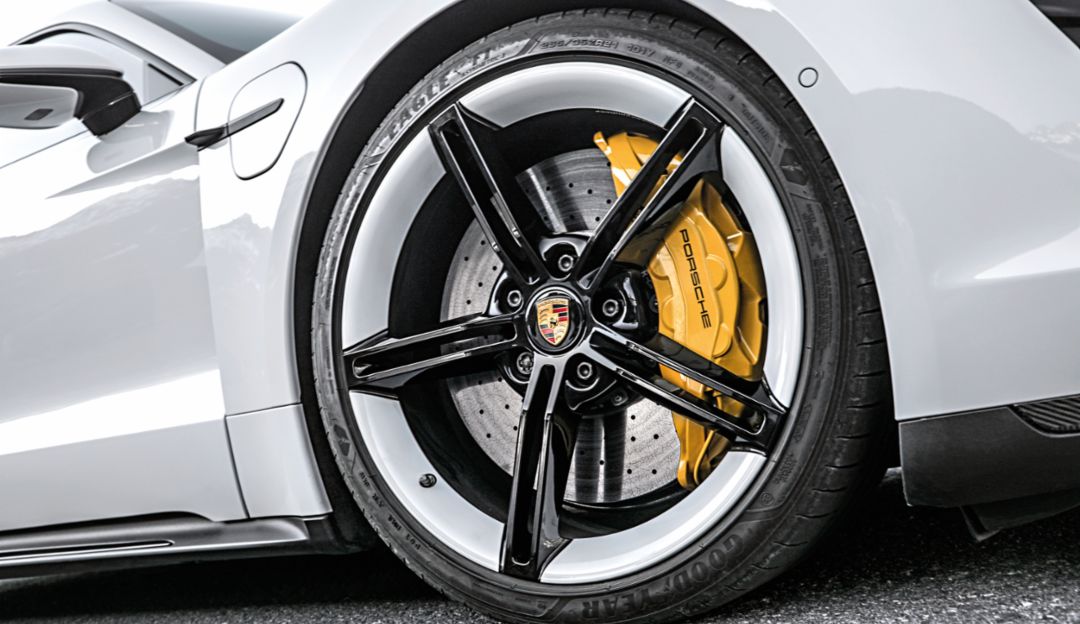
Body
The recessed door handles extend electrically with one press of the remote control. Concealed while the vehicle is moving, they reinforce the purist and discreet overall impression of the Taycan. Charging connections in the front mudguards allow for electricity to be pumped in conveniently. The area between the mudguards is maximally structured: the striking body indents and the use of lit edges in combination with the black side skirts lead to an emphatically self-confident, dynamic appearance.
Deep, wide sports-car look
Particularly striking are the muscular fenders and the slim driver’s cab, known as the greenhouse. Together with the horizontal lines, the vehicle body has been given its strikingly strong waistline and the deep, wide, typical Porsche look. Another characteristic feature of the sports cars from Zuffenhausen is the low-positioned, adaptive rear spoiler, which extends according to the driving situation—variable in three stages with the Taycan. The aerodynamically optimized rear diffuser with a lamella design finishes the bottom of the vehicle with a very low license plate. This brings the Taycan closer to the asphalt.

